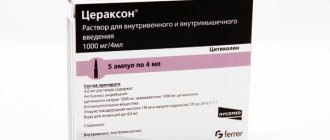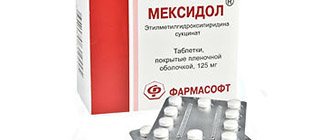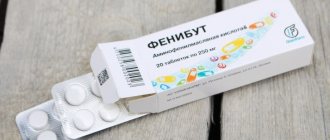Ceraxon tablets: composition and action
Ceraxon is sold in several forms:
- injections;
- pills;
- solution for systemic use.
The tablets contain the main active ingredient – citicoline sodium. In addition to this, the composition includes:
- talc;
- castor oil;
- magnesium stearate.
Tablets are packed in 5 pieces in a blister, each box contains 4 blisters. The solution intended for drinking contains the same basic substance - citicoline, and along with it glycerin, sorbidol, sodium citrate, sodium saccharinate, strawberry flavoring. This composition is packaged in unpainted glass bottles with plastic caps. The volume of one bottle is 30 ml. It is convenient to dose using the syringe included in each package.
The drug for administration into a vein is packaged in glass ampoules, with a break line marked. One cardboard package can contain 3 or 5 pieces. Ceraxon mainly acts on brain cells, strengthening membranes, improving the functions of ion exchange pumps of the nervous system, which is due to the production of phospholipids.
In case of severe swelling, the action of the drug relieves pressure at the site of the lesion, which returns the cognitive functions of the brain. In addition, the ability to concentrate is restored and memory improves. If Cerakson is applied promptly at the first symptoms of a stroke, it will be possible to minimize the area of spread of necrotic tissue.
Citicoline is one of the constant elements of the human body, which does not make it possible to evaluate its pharmacokinetics. The substance entering through the gastrointestinal tract is absorbed almost completely. As a rule, 1-2% of the total ingested volume remains unabsorbed. Citicoline is excreted through the kidneys in the urine.
As a result of hepatic metabolism processes, two substances are formed: cytidine and choline. Citicoline is first concentrated in the structures and tissues of the brain. At the same time, fractions of the resulting choline pass into phospholipids, and cytidine derivatives into the composition of nucleic acids.
Ceraxon, 10 pcs., 10 ml, 100 mg/ml, oral solution
Solution for intravenous, intramuscular administration.
IV, in the form of a slow IV injection (over 3–5 minutes, depending on the prescribed dose) or IV drip infusion (40–60 drops per minute).
The intravenous route of administration is preferable to the intramuscular route. When administered intramuscularly, repeated administration of the drug in the same place should be avoided.
Recommended dosage regimen
Acute period of ischemic stroke and TBI:
1000 mg every 12 hours from the first day after diagnosis, duration of treatment for at least 6 weeks. 3–5 days after the start of treatment (if swallowing function is not impaired), it is possible to switch to oral forms of the drug Ceraxon®.
Recovery period of ischemic and hemorrhagic strokes, recovery period of TBI, cognitive and behavioral disorders in degenerative and vascular diseases of the brain:
500–2000 mg per day. The dosage and duration of treatment depend on the severity of the symptoms of the disease. It is possible to use oral forms of the drug Ceraxon®.
Elderly patients
When prescribing Ceraxon® to elderly patients, no dose adjustment is required.
The solution in the ampoule is intended for single use. It must be used immediately after opening the ampoule.
The drug is compatible with all types of intravenous isotonic solutions and dextrose solutions.
Oral solution.
Before use, the drug can be diluted in a small amount of water (120 ml or 1/2 cup). Take with meals or between meals.
Recommended dosage regimen
Acute period of ischemic stroke and TBI:
1000 mg (10 ml or 1 pack) every 12 hours. Treatment duration is at least 6 weeks.
Recovery period of ischemic and hemorrhagic strokes, recovery period of TBI, cognitive and behavioral disorders in degenerative and vascular diseases of the brain:
500–2000 mg per day (5–10 ml or 1 pack (1000 mg) 1–2 times a day). The dosage and duration of treatment depend on the severity of the symptoms of the disease.
Elderly patients
When prescribing Ceraxon® to elderly patients, no dose adjustment is required.
Instructions for using the dosing syringe (Fig. 1):
Picture 1.
1. Place the dosing syringe into the bottle (the syringe plunger is completely lowered) (Fig. 1 (1).
2. Carefully pull the plunger of the dosing syringe until the solution level is equal to the corresponding mark on the syringe (Fig. 1 (2).
3. Before taking, the required amount of solution can be diluted in 1/2 glass of water (120 ml) (Fig. 1 (3).
After each use, it is recommended to rinse the dosing syringe with water.
Recommendations for the use of Ceraxon® in sachets:
1. Separate one bag from another along the tear seam. Holding the bag vertically, carefully tear off its edge along the o (Fig. 2).
Figure 2.
2. The contents of the sachet can be drunk immediately after opening (Fig. 3) or before use can be diluted in 1/2 glass of water (120 ml) (Fig. 4).
Figure 3.
Figure 4.
When is Cerakson prescribed?
Treatment with Ceraxon is indicated in the following cases:
- first 4 hours during primary stroke;
- for rehabilitation after a stroke;
- emergency assistance and to restore the condition impaired as a result of severe head injury;
- cerebrovascular diseases that reduce cognitive function and provoke behavioral changes.
If the patient was administered Ceraxon in the first hours after a traumatic brain injury, the duration of post-traumatic coma will be less than without the help of the drug. In addition, there is a high probability of reducing the severity of neurological abnormalities typical of this type of injury.
If chronic hypoxia has become the reason for the predominance of lack of initiative in a person’s behavior, complete inability in matters of self-care, the drug effectively affects certain areas of the brain, restoring cognitive functions.
Cerakson
Marketing authorization holder: FERRER INTERNACIONAL, SA (Spain) Representative office: TAKEDA (Japan) ATX code: N06BX06 (Citicoline) Active substance: citicoline (citicoline) Rec.INN registered by WHO Dosage form CERAKSON® solution for oral administration 1000 mg/ 10 ml: pack. 6 or 10 pcs. reg. No.: LSR-000089 dated 05/31/07 - Validity period of reg. beat is not limited
Release form, composition and packaging Oral solution is a clear, colorless liquid with a characteristic strawberry odor.
1 ml citicoline sodium 104.5 mg, equivalent to citicoline 100 mg
Excipients: sorbitol - 200 mg, glycerol - 50 mg, methyl parahydroxybenzoate - 1.45 mg, propyl parahydroxybenzoate - 0.25 mg, sodium citrate dihydrate - 6 mg, sodium saccharinate - 0.2 mg, strawberry flavor (strawberry essence 1487-S-Lucta) - 0.408 mg , potassium sorbate - 3 mg, citric acid solution 50% - up to pH 5.9-6.1, purified water - up to 1 ml.
30 ml - colorless glass bottles (1) complete with a dosage syringe - cardboard packs with partitions.
The solution for oral administration is a clear, colorless liquid with a characteristic strawberry odor.
1 pack (10 ml) citicoline sodium 1045 mg, equivalent to citicoline 1000 mg
Excipients: sorbitol - 2000 mg, glycerol - 500 mg, methyl parahydroxybenzoate - 14.5 mg, propyl parahydroxybenzoate - 2.5 mg, sodium citrate dihydrate - 60 mg, sodium saccharinate - 2 mg, strawberry flavor (strawberry essence 1487-S-Lucta) - 4.08 mg , potassium sorbate - 30 mg, citric acid solution 50% - up to pH 5.9-6.1, purified water - up to 10 ml.
10 ml - sachets of combined material (6) - cardboard packs. 10 ml - sachets of combined material (10) - cardboard packs.
The solution for intravenous and intramuscular administration is a clear, colorless liquid.
1 amp. citicoline sodium 522.5 mg, equivalent to citicoline 500 mg
Excipients: hydrochloric acid 1 M or sodium hydroxide 1 M - up to pH 6.7-7.1, water for injection - up to 4 ml.
4 ml - colorless glass ampoules (3) - contour cell packaging (1) - cardboard packs. 4 ml - colorless glass ampoules (5) - contour cell packaging (1) - cardboard packs. 4 ml - colorless glass ampoules (10) - contour cell packaging (2) - cardboard packs.
The solution for intravenous and intramuscular administration is a clear, colorless liquid.
1 amp. citicoline sodium 1045 mg, equivalent to citicoline 1000 mg
Excipients: hydrochloric acid 1 M or sodium hydroxide 1 M - up to pH 6.7-7.1, water for injection - up to 4 ml.
4 ml - colorless glass ampoules (3) - contour cell packaging (1) - cardboard packs. 4 ml - colorless glass ampoules (5) - contour cell packaging (1) - cardboard packs. 4 ml - colorless glass ampoules (10) - contour cell packaging (2) - cardboard packs.
Clinical-pharmacological group: Nootropic drug Pharmaco-therapeutic group: Nootropic drug
Indications: acute period of ischemic stroke (as part of complex therapy),
- recovery period of ischemic and hemorrhagic strokes,
— traumatic brain injury, acute (as part of complex therapy) and recovery period,
— cognitive and behavioral disorders in degenerative and vascular diseases of the brain.
ICD-10 codes ICD-10 code Indication F07 Personality and behavioral disorders caused by disease, damage or dysfunction of the brain I63 Cerebral infarction (ischemic cerebrovascular accident) I69 Consequences of cerebrovascular diseases S06 Intracranial injury T90 Consequences of head injuries
Dosage regimen Oral solution
The drug is taken with meals or between meals. Before use, the drug can be diluted in a small amount of water (120 ml or 1/2 cup).
Acute period of ischemic stroke and traumatic brain injury: the recommended dose is 1000 mg (10 ml or 1 sachet) every 12 hours. Duration of treatment is at least 6 weeks.
Recovery period of ischemic and hemorrhagic strokes, recovery period of traumatic brain injury, cognitive and behavioral disorders in degenerative and vascular diseases of the brain: the recommended dose is 500-2000 mg/day (5-10 ml 1-2 times/day or 1 sachet ( 1000 mg) 1-2 times/day). The dose and duration of treatment depend on the severity of the symptoms of the disease.
Elderly patients do not require dose adjustment of Ceraxon®.
Rules for using a dosage syringe
1. Place the dosing syringe into the bottle (the syringe plunger is completely lowered).
2. Carefully pull the plunger of the dosing syringe until the solution level is equal to the corresponding mark on the syringe.
3. Before taking, the required amount of solution can be diluted in 1/2 glass of water (120 ml).
After each use, it is recommended to rinse the dosing syringe with water.
Rules for using the drug in sachets
1. Holding the bag vertically, carefully tear off its edge along the o.
2.The contents of the sachet can be drunk immediately after opening or before use can be diluted in 1/2 glass of water (120 ml).
Solution for intravenous and intramuscular administration
The drug is administered intravenously as a slow injection (over 3-5 minutes, depending on the prescribed dose) or drip infusion (40-60 drops/min). The intravenous route of administration is preferable to the intramuscular route. When administered intramuscularly, repeated administration of the drug in the same place should be avoided.
Acute period of ischemic stroke and traumatic brain injury: the recommended dose is 1000 mg every 12 hours from the first day after diagnosis, treatment duration is at least 6 weeks. 3-5 days after the start of treatment (if swallowing function is not impaired), it is possible to switch to oral forms of the drug Ceraxon®.
Recovery period for ischemic and hemorrhagic strokes, recovery period for traumatic brain injury, cognitive and behavioral disorders in degenerative and vascular diseases of the brain: the recommended dose is 500-2000 mg/day (5-10 ml 1-2 times/day). The dose and duration of treatment depend on the severity of the symptoms of the disease.
Elderly patients do not require dose adjustment of Ceraxon® for intravenous or intramuscular administration.
A solution for intravenous and intramuscular administration in an ampoule is intended for single use. After opening the ampoule, the solution should be used immediately. The drug is compatible with all types of intravenous isotonic solutions and dextrose solutions.
Side effects Very rare (<.1/10,000) (including individual cases): allergic reactions (rash, itching, anaphylactic shock), headache, dizziness, feeling of heat, tremor, nausea, vomiting, diarrhea, hallucinations, swelling, shortness of breath, insomnia, agitation, loss of appetite, numbness in paralyzed limbs, changes in the activity of liver enzymes. In some cases, Ceraxon® can stimulate the parasympathetic system and also cause a short-term change in blood pressure.
If any of the side effects indicated in the instructions get worse, or any other side effects not listed in the instructions are noticed, you should inform your doctor.
Contraindications for use: severe vagotonia (predominance of the tone of the parasympathetic part of the autonomic nervous system),
- children and adolescents under 18 years of age (due to the lack of sufficient clinical data),
- rare hereditary diseases associated with fructose intolerance (for oral solution),
- hypersensitivity to the components of the drug.
Use during pregnancy and lactation There is not enough clinical data on the use of citicoline during pregnancy. Although experimental studies on animals have not revealed any negative effects, during pregnancy the drug is prescribed only when the expected benefit of therapy for the mother outweighs the potential risk to the fetus.
If it is necessary to use the drug during lactation, the issue of stopping breastfeeding should be decided, since there is no data on the excretion of citicoline in breast milk.
Use in children Contraindicated in children and adolescents under 18 years of age.
Use in elderly patients Elderly patients do not require dose adjustment of Ceraxon®. Special instructions In the solution for oral administration in the cold, a small amount of crystals may form due to temporary partial crystallization of the preservative. With further storage under recommended conditions, the crystals dissolve within several months. The presence of crystals does not affect the quality of the drug.
Impact on the ability to drive vehicles and operate machinery
During the treatment period, patients should be careful when performing potentially hazardous activities that require special attention and speed of psychomotor reactions (including driving a car and other vehicles, working with moving mechanisms, working as a dispatcher and operator).
Overdose Due to the low toxicity of the drug, cases of overdose have not been described.
Drug interactions Citicoline enhances the effects of levodopa.
Ceraxon® should not be prescribed concomitantly with medications containing meclofenoxate.
Conditions for dispensing from pharmacies The drug is dispensed with a prescription.
Conditions and periods of storage The drug should be stored out of the reach of children at a temperature not exceeding 30°C. Shelf life: 3 years.
Ceraxon 1000: instructions
Intravenous administration of the drug Ceraxon 1000 should be carried out slowly and evenly, avoiding the creation of a strong stream of flow. When administering drips, the lamb should be in the middle position, which provides up to 60 drops per minute. Jet injection, including into an elastic band, is carried out by applying gentle pressure on the syringe piston. The effectiveness of the drug directly depends on the time of treatment. The sooner the patient was admitted to the care of physicians, and the earlier drug treatment was started, the more positive the result will be.
Ceraxon 1000 is a classic dosage for the treatment of stroke of various etiologies and to minimize the consequences of traumatic brain injuries, which is administered every 12 hours for 6 weeks. After which, if the patient has not lost the swallowing reflex, intravenous administration is replaced by systemic administration through tablets.
If treatment involves taking the solution orally, it must be diluted in 100 ml of drinking water. Drink the medicine with meals. Children may be prescribed the drug in cases of damage to the central nervous system. The dosage for the child is prescribed by the attending physician, depending on his weight, age and condition.
Cerakson solution for oral administration 100 mg/ml 10 ml pack/pack card x10
Marketing authorization holder: FERRER INTERNACIONAL, SA (Spain) Representative office: TAKEDA (Japan) ATX code: N06BX06 (Citicoline) Active substance: citicoline (citicoline) Rec.INN registered by WHO Dosage form CERAKSON® solution for oral administration 1000 mg/ 10 ml: pack. 6 or 10 pcs. reg. No.: LSR-000089 dated 05/31/07 - Validity period of reg. beat is not limited
Release form, composition and packaging Oral solution is a clear, colorless liquid with a characteristic strawberry odor.
1 ml citicoline sodium 104.5 mg, equivalent to citicoline 100 mg
Excipients: sorbitol - 200 mg, glycerol - 50 mg, methyl parahydroxybenzoate - 1.45 mg, propyl parahydroxybenzoate - 0.25 mg, sodium citrate dihydrate - 6 mg, sodium saccharinate - 0.2 mg, strawberry flavor (strawberry essence 1487-S-Lucta) - 0.408 mg , potassium sorbate - 3 mg, citric acid solution 50% - up to pH 5.9-6.1, purified water - up to 1 ml.
30 ml - colorless glass bottles (1) complete with a dosage syringe - cardboard packs with partitions.
The solution for oral administration is a clear, colorless liquid with a characteristic strawberry odor.
1 pack (10 ml) citicoline sodium 1045 mg, equivalent to citicoline 1000 mg
Excipients: sorbitol - 2000 mg, glycerol - 500 mg, methyl parahydroxybenzoate - 14.5 mg, propyl parahydroxybenzoate - 2.5 mg, sodium citrate dihydrate - 60 mg, sodium saccharinate - 2 mg, strawberry flavor (strawberry essence 1487-S-Lucta) - 4.08 mg , potassium sorbate - 30 mg, citric acid solution 50% - up to pH 5.9-6.1, purified water - up to 10 ml.
10 ml - sachets of combined material (6) - cardboard packs. 10 ml - sachets of combined material (10) - cardboard packs.
The solution for intravenous and intramuscular administration is a clear, colorless liquid.
1 amp. citicoline sodium 522.5 mg, equivalent to citicoline 500 mg
Excipients: hydrochloric acid 1 M or sodium hydroxide 1 M - up to pH 6.7-7.1, water for injection - up to 4 ml.
4 ml - colorless glass ampoules (3) - contour cell packaging (1) - cardboard packs. 4 ml - colorless glass ampoules (5) - contour cell packaging (1) - cardboard packs. 4 ml - colorless glass ampoules (10) - contour cell packaging (2) - cardboard packs.
The solution for intravenous and intramuscular administration is a clear, colorless liquid.
1 amp. citicoline sodium 1045 mg, equivalent to citicoline 1000 mg
Excipients: hydrochloric acid 1 M or sodium hydroxide 1 M - up to pH 6.7-7.1, water for injection - up to 4 ml.
4 ml - colorless glass ampoules (3) - contour cell packaging (1) - cardboard packs. 4 ml - colorless glass ampoules (5) - contour cell packaging (1) - cardboard packs. 4 ml - colorless glass ampoules (10) - contour cell packaging (2) - cardboard packs.
Clinical-pharmacological group: Nootropic drug Pharmaco-therapeutic group: Nootropic drug
Indications: acute period of ischemic stroke (as part of complex therapy),
- recovery period of ischemic and hemorrhagic strokes,
— traumatic brain injury, acute (as part of complex therapy) and recovery period,
— cognitive and behavioral disorders in degenerative and vascular diseases of the brain.
ICD-10 codes ICD-10 code Indication F07 Personality and behavioral disorders caused by disease, damage or dysfunction of the brain I63 Cerebral infarction (ischemic cerebrovascular accident) I69 Consequences of cerebrovascular diseases S06 Intracranial injury T90 Consequences of head injuries
Dosage regimen Oral solution
The drug is taken with meals or between meals. Before use, the drug can be diluted in a small amount of water (120 ml or 1/2 cup).
Acute period of ischemic stroke and traumatic brain injury: the recommended dose is 1000 mg (10 ml or 1 sachet) every 12 hours. Duration of treatment is at least 6 weeks.
Recovery period of ischemic and hemorrhagic strokes, recovery period of traumatic brain injury, cognitive and behavioral disorders in degenerative and vascular diseases of the brain: the recommended dose is 500-2000 mg/day (5-10 ml 1-2 times/day or 1 sachet ( 1000 mg) 1-2 times/day). The dose and duration of treatment depend on the severity of the symptoms of the disease.
Elderly patients do not require dose adjustment of Ceraxon®.
Rules for using a dosage syringe
1. Place the dosing syringe into the bottle (the syringe plunger is completely lowered).
2. Carefully pull the plunger of the dosing syringe until the solution level is equal to the corresponding mark on the syringe.
3. Before taking, the required amount of solution can be diluted in 1/2 glass of water (120 ml).
After each use, it is recommended to rinse the dosing syringe with water.
Rules for using the drug in sachets
1. Holding the bag vertically, carefully tear off its edge along the o.
2.The contents of the sachet can be drunk immediately after opening or before use can be diluted in 1/2 glass of water (120 ml).
Solution for intravenous and intramuscular administration
The drug is administered intravenously as a slow injection (over 3-5 minutes, depending on the prescribed dose) or drip infusion (40-60 drops/min). The intravenous route of administration is preferable to the intramuscular route. When administered intramuscularly, repeated administration of the drug in the same place should be avoided.
Acute period of ischemic stroke and traumatic brain injury: the recommended dose is 1000 mg every 12 hours from the first day after diagnosis, treatment duration is at least 6 weeks. 3-5 days after the start of treatment (if swallowing function is not impaired), it is possible to switch to oral forms of the drug Ceraxon®.
Recovery period for ischemic and hemorrhagic strokes, recovery period for traumatic brain injury, cognitive and behavioral disorders in degenerative and vascular diseases of the brain: the recommended dose is 500-2000 mg/day (5-10 ml 1-2 times/day). The dose and duration of treatment depend on the severity of the symptoms of the disease.
Elderly patients do not require dose adjustment of Ceraxon® for intravenous or intramuscular administration.
A solution for intravenous and intramuscular administration in an ampoule is intended for single use. After opening the ampoule, the solution should be used immediately. The drug is compatible with all types of intravenous isotonic solutions and dextrose solutions.
Side effects Very rare (<.1/10,000) (including individual cases): allergic reactions (rash, itching, anaphylactic shock), headache, dizziness, feeling of heat, tremor, nausea, vomiting, diarrhea, hallucinations, swelling, shortness of breath, insomnia, agitation, loss of appetite, numbness in paralyzed limbs, changes in the activity of liver enzymes. In some cases, Ceraxon® can stimulate the parasympathetic system and also cause a short-term change in blood pressure.
If any of the side effects indicated in the instructions get worse, or any other side effects not listed in the instructions are noticed, you should inform your doctor.
Contraindications for use: severe vagotonia (predominance of the tone of the parasympathetic part of the autonomic nervous system),
- children and adolescents under 18 years of age (due to the lack of sufficient clinical data),
- rare hereditary diseases associated with fructose intolerance (for oral solution),
- hypersensitivity to the components of the drug.
Use during pregnancy and lactation There is not enough clinical data on the use of citicoline during pregnancy. Although experimental studies on animals have not revealed any negative effects, during pregnancy the drug is prescribed only when the expected benefit of therapy for the mother outweighs the potential risk to the fetus.
If it is necessary to use the drug during lactation, the issue of stopping breastfeeding should be decided, since there is no data on the excretion of citicoline in breast milk.
Use in children Contraindicated in children and adolescents under 18 years of age.
Use in elderly patients Elderly patients do not require dose adjustment of Ceraxon®. Special instructions In the solution for oral administration in the cold, a small amount of crystals may form due to temporary partial crystallization of the preservative. With further storage under recommended conditions, the crystals dissolve within several months. The presence of crystals does not affect the quality of the drug.
Impact on the ability to drive vehicles and operate machinery
During the treatment period, patients should be careful when performing potentially hazardous activities that require special attention and speed of psychomotor reactions (including driving a car and other vehicles, working with moving mechanisms, working as a dispatcher and operator).
Overdose Due to the low toxicity of the drug, cases of overdose have not been described.
Drug interactions Citicoline enhances the effects of levodopa.
Ceraxon® should not be prescribed concomitantly with medications containing meclofenoxate.
Conditions for dispensing from pharmacies The drug is dispensed with a prescription.
Conditions and periods of storage The drug should be stored out of the reach of children at a temperature not exceeding 30°C. Shelf life: 3 years.
Contraindications for use
If, as a result of diagnosing the patient’s condition, the following features are revealed, Cerakson is not prescribed:
- individual intolerance to one of the components of the drug;
- tone of the autonomic nervous system, in its parasympathetic part;
- hereditary fructose intolerance.
Adverse reactions during treatment with Cerakson are extremely rare, among them are:
- coordination problems;
- pain in the occipital region;
- diarrhea;
- appetite disorders;
- insomnia;
- rash.
Sometimes short-term changes in blood pressure are observed, as well as loss of sensation, mainly in the arm and leg on the paralyzed side, if the patient has suffered a stroke.
If any of these reactions occur, you should discuss changing the course of therapy with your doctor.
special instructions
Treatment with Cerakson is often prescribed to premature babies and newborns with brain tissue injuries received during childbirth. The treatment regimen is determined by the attending physician and depends on the Apgar assessment of the child’s condition. Storing the medicine in the refrigerator may cause crystals to form in the solution. It will take at least two months at room temperature to dissolve them. Despite the fact that this does not reduce the quality of the active substance, the drug should still be stored at room temperature not exceeding +30 C.
The empty packaging of the drug must be used within three years from the date of release.







